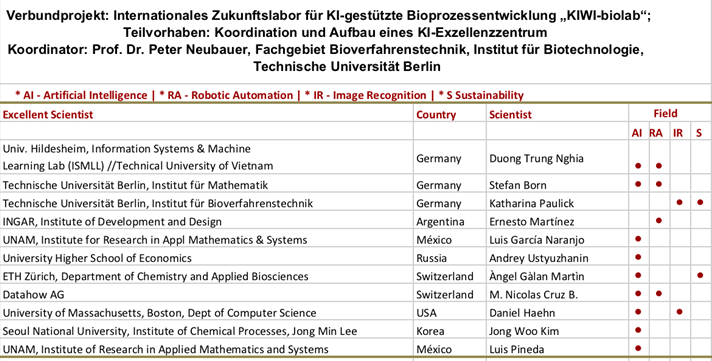introduction to the KIWI-biolabs project
Machine learning/AI, AnIML / SiLA2 to close the loop in LifeScience Robotics.
dr. mark doerr
institute for biochemistry, university greifswald/tu-berlin/uni-hildesheim
Greifswald, 2020-06-04

Any element with the class="notes" will not be displayed. This can
be used for speaker notes. In fact, the impressConsole plugin will
show it in the speaker console!
Press ctrl-C to activate the console
the greifswald protein screening platform LARA
* lara intro
LARA - real robotics at the institute for biochemistry
- protein screening engineering
- screening for new substrate scopes / altered substrate specificity
- enhanced enzyme stability
- directed evolution approaches
- findind the right enzyme in 1E5 to 1E9 variants
* protein screening engineering
* findind the right enzyme in 1E5 to 1E9 variants
* lara movie
* protein screening engineering
* findind the right enzyme in 1E5 to 1E9 variants
* lara movie
KIWI project - overview
- highly interdiciplinariy project between Biotechnology, Mathematics, Machine Learning, Robotics and Software Engineering
- developing autonomous biolabs by creating and tailoring existing ML tools for biotech
- closing the feedback loop between Mathematical Model/Machine Learning and real Robotics - toward autonomous experimentation
- connecting different automated labs, located at different sites.
- biotechnological goals: optimisation of protein activity and protein yield for production
- the project will have:
- 5 PhD students - open position at University-Greifswald
- ~10 scientists
- ~20 partners from academia - as consultands
- > 4 companies involved
* In the very early days of personal computing, I was wondering, why the computer was not used
KIWI - partners

* protein screening engineering
* findind the right enzyme in 1E5 to 1E9 variants
* lara movie
scientific data - structure
* In the very early days of personal computing, I was wondering, why the computer was not used
LARA suite ( gitlab.com/larasuite )
- planning of experiments
- storing all required data for the planning, like literature, substances, material, devices, experimentalists ...
- generating the processes
- execution of the processes, communication with the lab devices
- collection of the data (very structured, well prepared to learn from it)
- evaluation and visualisation of the data (also DoE and machine learning)
- reporting / publishing / exchange between labs
* In the very early days of personal computing, I was wondering, why the computer was not used
LARA suite - technologies
- all open source based
- languages: python3, (R) and JavaScript
- very compact code, usage of standard library, minimum dependencies
- gRPC as universal wire format (SiLA2 communication) and web front-end / backend (no REST !!)
- AnIML as long term storage and data exchange format (planned)
- one language paradigm for all !
- python-django web framework and database ORM- very simple access
- flexible relational database schema, fitting many lab workflows
summary: KIWI-biolabs, LARA and AnIML
building the lab of the future - how do we all benefit ?
- machine learning in BioTech and LifeScience applications
- closing the loop of autonomous, machine guided experimentation
- standadised data exchange between remote robotics labs
- high meta-data content for improved AI/Machine Learning
- possiblity to re-interpret / re-evaluate the data in the future with evolved knowledge
- SiLA as commincation standard between the components
- long term data storage
- free and open source python AnIML implementation: https://gitlab.com/LARAsuite/animl_python
* In the very early days of personal computing, I was wondering, why the computer was not used
acknowledgements
robot hard- and software
- Stefan Born (TU Berlin)
- Peter Neubauer with his group (TU Berlin)
- Johannes Kabisch with his group and associates (TU Darmstadt)
- Egon Heuson (REALCAT/Lille France)
- The SiLA core working group
- The AnIML core working group
general thanks to
-
 Uwe Bornscheuer
Uwe Bornscheuer - Financing: Deutsche Forschungsgemeinschaft (DFG), BMBF and federal state of Mecklenburg-Vorpommern
THANX !